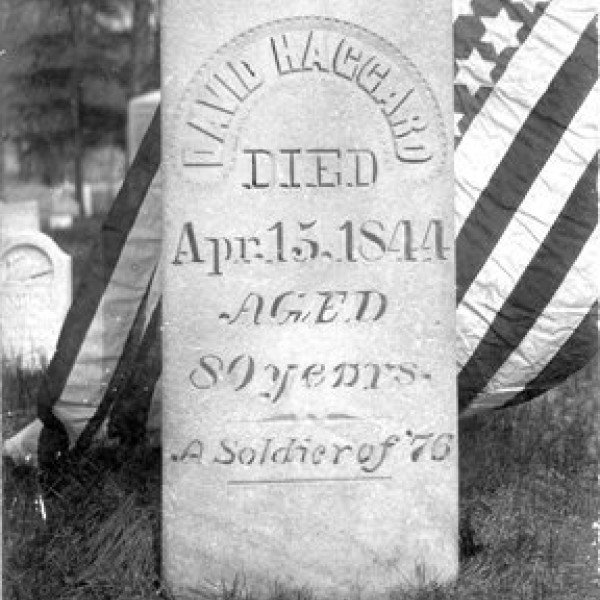David Haggard was proud of his family tree. David was a descendant of Sir Andrew Ogard, a Knight of Bradenham Castle in County Norfolk which lies on the east side of England along the North Sea. Sir Andrew Ogard was from a distinguished family in Denmark and was naturalized by King Henry VI of England in 1433. The first Haggard family member to arrive in America was David Haggard’s grandfather, James Haggard. He left England in about 1698 and arrived in Norfolk, Virginia where he became a school teacher.
David Haggard was born on February 4, 1764 in Albemarle County, Virginia. He was born to Nathaniel Haggard and Elizabeth Gentry Haggard. They had ten children: Henry, Martin, Elizabeth, John, Mary, James, Jane, David and Bartlett, who were twins, and Nathaniel.
David Haggard is most known for being a soldier in the American Revolutionary War. In March of 1781 at the age of 16 he enlisted at Moppen Hills, eighteen miles south of Richmond and served in the Virginia Militia for about six months during the Revolutionary War. He was a private under Captains Harris, Martin, and Fry and Colonels Richardson and Matthews. According to family tradition, while David was in the military his twin brother Bartlett, who was not enlisted, would sneak into the camp and change clothes with David. David was then free to go home and visit his family and “no one would be the wiser.” During his time in the army, David was present during the Battle of Yorktown on October 14th, 1781. The surrender of the British at Yorktown was a pivotal moment of the War for Independence ending the fighting in what would become the United States. The joint effort of the American forces lead by General George Washington and the French forces lead by General Comte de Rochambeau, surrounded Cornwallis by land and by sea, exhausting British supplies, forcing Cornwallis to unconditionally surrender on October 19th, 1781. After these events, he was put on duty as guardian of the British prisoners of war until he was discharged in November 1781. David’s brothers, Henry and James, were also a part of the Virginia Militia. After the war David worked as a carpenter. He lived near President Thomas Jefferson and at times he was employed by the President to work on his home at Monticello.
In 1779 David Haggard married Nancy Dawson, the daughter of Reverend Martin Dawson, a Baptist Minister. They had two sons and eight daughters: Elizabeth, Dawson, Martha, John, Sally, Melvina, Cynthia, Mahalla, and Louesa and Louisa, who were twins. Their first child, Elizabeth, was born in Albemarle County, Virginia in 1791. In 1788, David’s parents and many of his brothers and sisters moved to Clark County, Kentucky in the central part of the state which was at that time a wilderness. There David’s father built a house made of hewn cherry logs with port-holes for defense against the Indians who were troublesome at the time. David and his wife followed his family to Kentucky between the birth of their first child and their second (in 1792). All of their remaining nine children were born after 1792 in Kentucky.
In 1823 the Haggard’s moved to Trigg County, Kentucky. Then in 1836 they moved to Bloomington, Illinois residing at 319 South Center Street. The population in Bloomington at this time was a mere 450 inhabitants. Haggard would spend the rest of his life in Bloomington.
In Bloomington, Haggard was active in organizing the First Baptist Church. Towards the end of his life he applied for a military pension for his service during the Revolutionary War. However, his request was denied on March 4th, 1841 because he failed to supply enough proof of serving at least six months as required by the pension law passed by Congress in 1832.
On April 15, 1844 Haggard died at the age of 80 and was buried at Evergreen Memorial Cemetery in Bloomington, Illinois. He is the only known soldier of the Revolutionary War to be buried in Bloomington, Illinois. His wife Nancy died sometime between 1850 and 1860. In 1913 David’s name was included on the Soldiers and Sailors Monument in Miller Park erected by McLean County. In 1926 Haggard’s grave was marked by the Letitia Green Stevenson Chapter of the Daughters of the American Revolution.
Haggard, David
(February 4, 1764 — April 15, 1844)
Written by Lisa Dretske. 5 min read.


MLA:
Dretske, Lisa. “Haggard, David.” McLean County Museum of History, 2009, mchistory.org/research/biographies/haggard-david. Accessed 16 Dec. 2025. APA:
Dretske, L. (2009). Haggard, David. McLean County Museum of History, https://mchistory.org/research/biographies/haggard-david Chicago:
Dretske, Lisa. “Haggard, David.” McLean County Museum of History. 2009. Retrieved from https://mchistory.org/research/biographies/haggard-david
Dretske, Lisa. “Haggard, David.” McLean County Museum of History, 2009, mchistory.org/research/biographies/haggard-david. Accessed 16 Dec. 2025. APA:
Dretske, L. (2009). Haggard, David. McLean County Museum of History, https://mchistory.org/research/biographies/haggard-david Chicago:
Dretske, Lisa. “Haggard, David.” McLean County Museum of History. 2009. Retrieved from https://mchistory.org/research/biographies/haggard-david